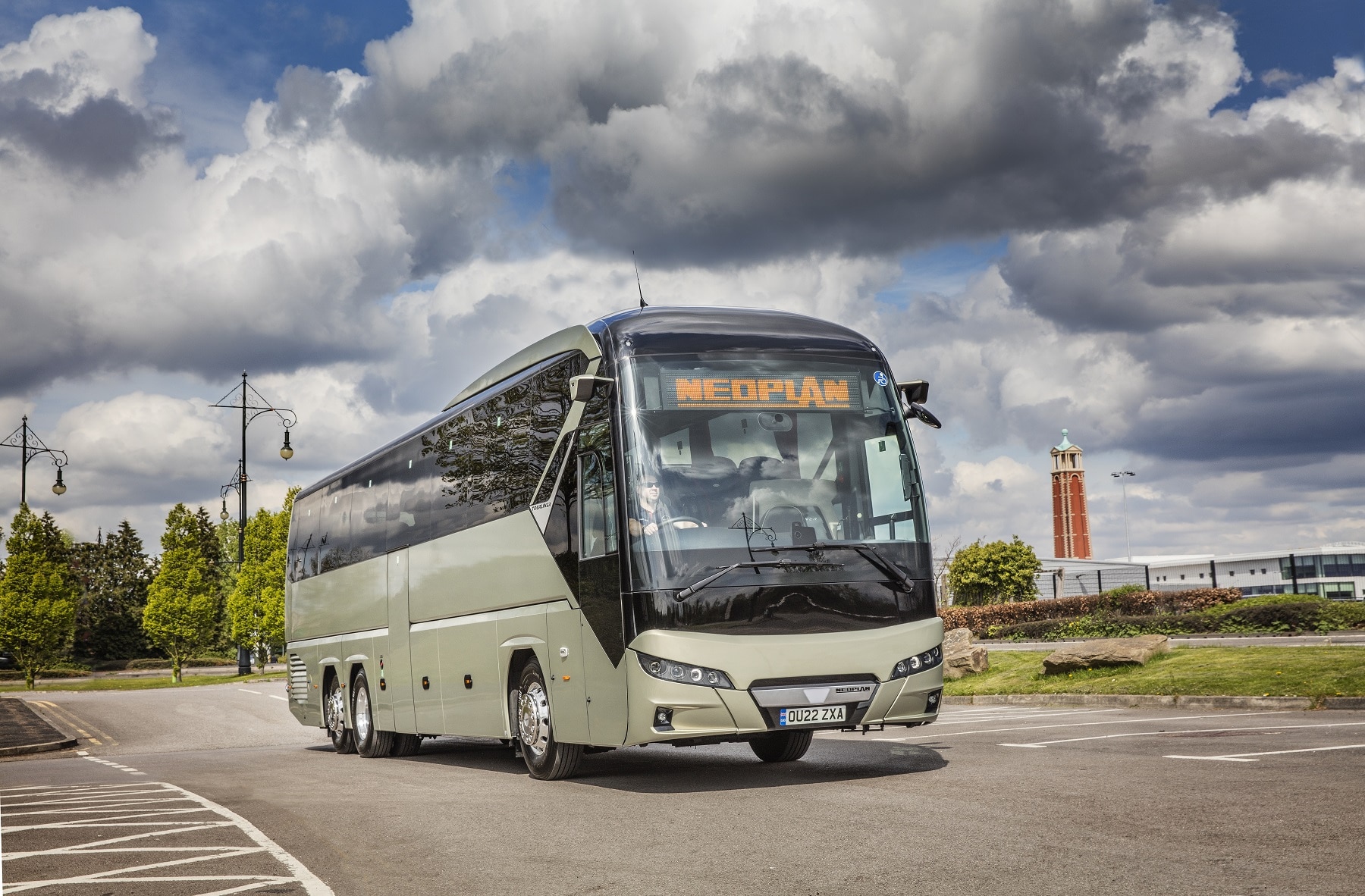In 2019, MAN came to the table with rear-view cameras for a coach when its OptiView system was prototyped on a Neoplan Cityliner. After further development, the OEM productionised OptiView and it recently debuted the technology in the UK Neoplan line-up on two Tourliner demonstrators.
Only one of those coaches – a 13.4m P20 – remains with MAN after the other – a P10 – was sold to Go Goodwins. The P20 has a customer evaluation programme in hand that began with Spencer Graham Coaches in late April. The Cumbrian operator used it first on Megabus work thanks to its PSVAR compliant specification, which is achieved ex-factory with the help of a Hübner lift and two wheelchair user spaces.
Before that, routeone was the first UK media representative to drive either coach. While OptiView is the most obvious change on the P20, it brings other Tourliner firsts to the UK. One is under the bonnet; the demonstrator packs 510bhp from its 12.4-litre D26 engine at Euro VI step E.
At that rating, the D26 delivers 2,600Nm of torque, meaning that it can only be mated to the ZF Traxon automated manual gearbox. Customers requiring the EcoLife will find that 470bhp and 2,300Nm is their maximum, although past experience with that driveline showed that it is ample in a coach application.
Neoplan Tourliner OptiView demo bristles with tech
The P20 demonstrator has adaptive cruise control (ACC) with stop-and-go functionality. The additional module allows the coach to come to a halt for up to two seconds and then restart without the driver’s intervention. It extends the benefit of ACC and utilises the existing radar system and a camera.

Although the M60 motorway was moderately congested while routeone had charge of the P20, there was no scope to explore stop-and-go.
MAN’s literature shows that drivers should familiarise themselves with the technology if they are to get the best from it; it is not a one-click operation.
Stop-and-go is only available with Traxon, but it can also be had on suitable MAN coach chassis.
Also fitted to the P20 is AttentionGuard. It uses the lane departure warning system to identify ‘drifting’ that suggests the driver is fatigued, and issues acoustic and visual warnings urging a break. Perhaps fortuitously, AttentionGuard was also not tested on the M60.
The D26 coupled to Traxon is a known combination. Peak torque arrives from 930rpm and that is reflected in the gearbox’s shifting strategy. It adopts a ‘lazy’ policy and generally keeps revs low when accelerating.
Progress is thus not made as rapidly as a lower-rated coach with EcoLife, but for a high-power model, the P20 gives striking economy. An unladen trip around the M60 returned 11.4mpg, although the low unladen weight for its class of 15,090kg is a factor. EfficientCruise and EfficientRoll – which use GPS to optimise gear selection and the use of momentum respectively – are also fitted.
Where a high-power coach will come into its own is when climbing. Even at the full 26,000kg GVW it is difficult to conceive of any motorway hill in the UK that will slow the 510bhp Tourliner.
Rear-view cameras the big ticket item on demonstrator
OptiView represents a big change for drivers. While MAN in the UK will likely stick with mirrors on future stock Tourliners, those built to order can already be specified with OptiView and retrofit is under development.
Echoing a conventional rear-view arrangement, OptiView has two cameras on each side. Presented on the A-pillar displays are standard and wide-angle views. MAN uses an upright unit that is similar in aspect to a conventional mirror for this purpose. It is split approximately one-third/two-thirds in favour of the standard view.

Camera feeds are passed through software before display to correct blemishes. The view to the rear is clear, but to the nearside the distance between the driver and the display requires great care when moving to the left. A longer look than would perhaps be necessary with a standard mirror arrangement is beneficial in congested traffic when the driver is new to OptiView.
On OptiView-equipped coaches, MAN supplies a pair of basic mirrors that are stowed in the luggage bay. They are for use should a camera fail or be damaged, and affix to the same mounting points. It is also investigating whether recordings can be taken from OptiView, mitigating any need for external CCTV cameras in the same location.
Training on OptiView important for Tourliner drivers
Data has not yet been published by MAN on the fuel economy from the OptiView units’ reduced drag, although figures of 7-8% have been suggested elsewhere.
The UK dealer says that while the proof-of-concept Cityliner generated positive feedback from operators that drove it in 2019, OptiView technology in its current iteration is significantly better. A key area for that work was the transition between sunlight and shadow on the display units, as was optimising the view during darkness.
Importantly for MAN in the UK, customer interest in OptiView is already present. The P10 generated much attention when shown at the UK Coach Rally, while the additional cost of no more than £3,000 over a mirror-equipped coach is modest. But one thing is as clear as the displays: When new technology is introduced, drivers must be trained to use it correctly.
Further pictures of the P22 Tourliner demonstrator here.



























